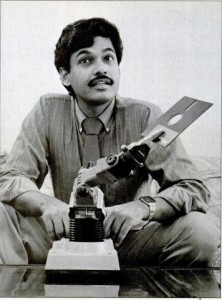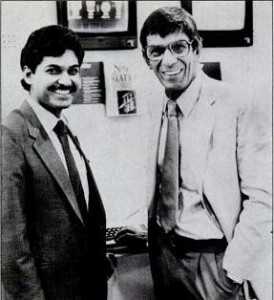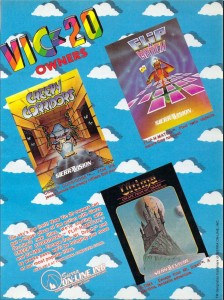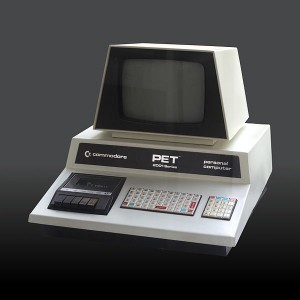Narayana Pillai Balakrishnan was a native of Cherthala, India, who, after traveling the world for years as a player of traditional Indian music, came to Hollywood in the early 1950s to teach the trendy new practice of Hatha Yoga to the stars. The software company founded by Jay — an Americanized shortening of “Sanjay” — Balakrishnan, the son he and his American wife raised there, would evince through its short, chaotic life a similar blending of idealism with commercialism.
Like many American children of Indian parents, Jay Balakrishnan kept one foot planted in each culture, spending much of his childhood and adolescence in schools in India’s Kerala region. During a summer break from the University of Southern Florida, he discovered computers while working at the Naval Electronics System Command in Charleston; he describes the discovery as a “religious experience.” When he went back to university, he “loaded up on computer-science courses.” After graduation, he worked as a programmer for GTE and later Hughes Helicopter. Meanwhile, in 1978 he bought his first Commodore PET, intending to use it only to do calculations for a course in piloting. But he soon found the PET every bit as entrancing as the big machines he worked with on his day job. He wrote an assembler, initially planning to submit it to a magazine as a type-in listing. However, his friends told him it was good enough to sell commercially, and so Balakrishnan founded Human Engineered Software (HES, or HESWare), out of his apartment on his 25th birthday in June of 1980.
Unlike the other early software companies I’ve profiled on this blog, HES got its start on the relatively unpopular — in North America, that is — Commodore PET. Otherwise, though, this story begins similarly. Balakrishnan wrote all of the early software himself, packaged it himself, shipped it himself when orders came in from the tiny advertisements he took out in magazines and newsletters like Kilobaud, Compute!, and The Midnite Software Gazette. Running on a PET with as little as 8 K of memory, those early products were, like the assembler that got the ball rolling — literally; he named it HESBal — mostly programming tools: a file editor called HESEdit, a BASIC program lister called HESLister.
HES was soon doing well enough for Balakrishnan to quit his job at Hughes. Still, running a one-man software company got exhausting quickly. He had elected to offer the ultimate in customer support in the form of a 24-hour help line; this kept him captive in his apartment waiting for the next ring, his sleep interrupted constantly. Thus when a manufacturer of monitors and other hardware called Universal Supply came to him with an offer to buy the company but let him continue to manage it, he was receptive. Balakrishnan and HESWare moved north to Brisbane, California, where he found a partner in running the operation in the form of an ex-Xerox manager named Ted Morgan. He also now had the funding to reach out to other platforms and other authors. Seeing Britain as a potential untapped source of software for the briefly but hugely popular Commodore VIC-20, he traveled to London to attend a computer show and do some networking in June of 1982. It was here that he met the man whose games would dramatically raise HES’s profile and enrich its bank account: Jeff Minter.
I could easily write several feature articles on Minter and the surrealistic action games which he continues to write to this very day; his distinctive style and psychedelic flair make him both one of gaming’s first auteurs and its most long-lived. But, at least for today, we’ll confine ourselves to his connection with HES. When Balakrishnan met him, he had just founded his long-lived British software house, Llamasoft, on the strength of a Defender clone called Andes Attack. It lacked the skewed originality of Minter’s later games, but Balakrishnan was nevertheless impressed with the fast graphics. He worked out a licensing deal, renamed it Aggressor, and moved it from cassette to a VIC-20 cartridge for the American market. Later that year came the much more original Gridrunner, Minter’s — and HES’s — first big hit. More lovably bizarre VIC-20 and Commodore 64 hits poured out of Minter at the rate of a new game every few months, many showing an odd fixation on ruminants: Attack of the Mutant Camels (probably his best-remembered game), Revenge of the Mutant Camels, Advance of the Megacamel, Metagalactic Llamas: Battle at the Edge of Time. HES’s sales jumped from $1.4 million to $13 million between 1982 and 1983, largely on the strength of cheap and cheerful VIC-20 and 64 cartridges — although Balakrishnan did try to keep his hand in other fields as well, releasing hardware expansions for the VIC-20 and a word processor called, inevitably, HESWriter for the 64.
That year the HES story took another unexpected twist. Parent company Universal Supply had been building equipment largely for Atari and Mattel. That suddenly became a very bad business to be in as the Great Videogame Crash of 1983 became a reality. Balakrishnan and Morgan managed to extricate HES from the collapsing Universal Supply, reincorporating it as an independent entity once again. With stars in their eyes, with everyone telling them their industry represented the next big wave in home entertainment, they now embarked on one of the most spectacular boom-and-busts of the home-computer era.
The first step in any good software flameout is to collect lots and lots of investment capital from folks as entranced as you are by the hype about your industry, but who are nevertheless guaranteed to want their money back when the hype doesn’t pan out. HES accepted huge cash injections from the major Silicon Valley venture-capitalist Tech Venture and from a company called Action Industries, a manufacturer of household knickknacks (!) based in Pennsylvania. Most interestingly, Microsoft also came on board. Their participation led to HES releasing a Commodore 64 version of Multiplan, Microsoft’s first attempt at a spreadsheet program in those years before the Office hegemony. Multiplan represents the only piece of software Microsoft would ever develop for the 64.
The next step is to overextend your distribution network. HES aggressively pushed their software into mass merchandisers like K-Mart and Toys “R” Us, opening the way for other publishers to do the same but paying dearly for the privilege of being first. By 1984 Balakrishan estimated that HES’s games were available through 8000 different outlets, while most competitors were only in 3000. This was good in its way, perhaps, but also meant that HES had to make a lot of copies right from the launch of each new title to have it available in so many places. And that in turn meant that when a new title turned out to be a flop — as did for example HESGames, an Olympic-themed effort that was roundly pummeled in the marketplace by Epyx’s Summer Games — they were left stuck with huge amounts of unsold inventory.
Finally, you have to spend hugely on advertising and promotion in comparison to the amount you spend on actually, you know, writing software. The remade HES made their first big promotional splash at Steve Wozniak’s second (and final) US Festival on Memorial Day Weekend 1983, where they had a big spread inside the tech expo. (At a press conference there HES’s spokesman inexplicably spilled the beans at considerable length about IBM’s still-secret PCjr project, to which HES, like a number of software companies, was privy. IBM was, needless to say, livid. An insider with whom I’m in occasional contact who was there claims the spokesman “might have been stoned — there were lots of drugs at that concert.”) They then rented a sort of permanent floating software exhibition on the retired aircraft carrier and newly minted museum ship Intrepid on Manhattan’s West Side. In early 1984 they made their biggest splash when they acquired the services of Leonard Nimoy as spokesman; if Commodore had used Captain Kirk to make the VIC-20 a raging success, they would use Mr. Spock to do the same for HES. Unfortunately, Nimoy seemed to know even less about computers than William Shatner; when asked what kind of computer he had at home, he said he didn’t know. (Nimoy was making a lot of strange career choices at this time, including driving a car for the Bangles in an incomprehensible music video for an admittedly pretty great song and plugging “erasable programmable logic devices” — Mr. Spock! get it? — something he presumably knew even less about than home computers, for Altera Corporation. InfoWorld magazine shruggingly concluded that he was maybe just “hard up for cash.”)
The somewhat, well, intellectual thrust of these promotional efforts, of using Mr. Spock as spokesman and hawking wares inside a museum, points to an interesting dichotomy about HES. They may have been rushing to hit the center of the mass market, but at the same time they weren’t dumbing down their products to do it. Far from it. HES was pushing hard to define themselves as a maker primarily of “edutainment” products. In a 1984 interview with InfoWorld, Balakrishnan describes an intriguing mix of upcoming high-concept titles, most of which would never see the light of day.
We’ve got a game called Cell Defense, in which you are in charge of your body’s immunological system, and viruses attack you. There are various levels. These affect how fast your cells reproduce and whether you are a sick or healthy organism. You are learning a lot about the body as you play the game.
Then we have another game called Reflections, that’s based on physics, with all kinds of lights and bouncing reflections. Then there’s Life Force, in which you essentially learn about genes and genetics. It has eight levels. In the first one, you create an amoeba, then you get into multi-celled organisms. Man is the seventh level. The eighth is the mystery one in which you create an unknown organism by taking ribosomes and nuclei and putting them together.
Our fourth game is called Ocean Quest, in which you go and look for sunken treasure. As you do that, you learn about undersea life. There are different scenarios that affect the game, such as whether you are in the Pacific or the Atlantic. Of course, undersea life and fish differ according to the region.
Following the videogame crash and burn, conventional wisdom held that the simple action games which had defined digital entertainment for the masses prior to that point were now passé — dangerously so, in fact. Tellingly, in that same InfoWorld interview Balakrishnan manages to never mention Jeff Minter or his games in describing HES’s rise to prominence. HES’s 1984 portfolio, like the bookware phenomenon, can be read as a sign of a home-computer software industry wanting to differentiate itself from videogames for very practical commercial reasons. Yet, just as most of the people producing bookware really, deeply believed in it as a potential revolution in reading, HES had plenty of idealism to accompany their excess. If they oversold how much the computers for which they produced software could actually do, well, that was down at least as much to their own dreamy technological utopianism as a simple need to move product. It was a strange, heady time in computer games.
Of course, it also couldn’t last, and for the overextended, over-expanded HES least of all. As these things so often do, the downfall came amazingly quickly. Leonard Nimoy debuted as HES’s spokesman in March of 1984. InfoWorld published the aforequoted ebullient profile of HES and Balakrishnan in their September 3, 1984, issue. Six weeks later the same magazine announced that “HES nears bankruptcy,” that they were casting about desperately for a buyer from amidst their erstwhile competitors while the investors bayed in outrage and flatly refused to throw good money after bad and the axe fell on two-thirds of their 90-person workforce. Days later they filed Chapter 11 bankruptcy. When asked what had happened, Morgan didn’t have a whole lot of insight to offer: “People stopped buying products.”
The remnants of HES were eventually acquired by Avant-Garde Publishing of Eugene, Oregon, a company which dated from the same year as HES and had its own fleet of eager venture capitalists behind it. Avant-Garde kept the HES name alive for a while; the original plan for the merger had the HES name being used for lower-end, mass-market software, the Avant-Garde name for higher-end IBM and Apple software to be sold through dealers. But, while Avant-Garde did keep a number of older HES titles in circulation for a time, they released just one new one under the label. Within a couple of years Avant-Garde too would be gone, justifiably so in light of cheesy efforts like Joe Theismann’s Pro Football, Dave Winfield’s Batter Up!, and Slugfest: Chris Evert-Lloyd Tennis, which purported to teach you or your kids how to play their respective sports with the help of their respective athlete endorsers.
Jay Balakrishnan continued undeterred as a serial entrepreneur. By the January 1985 Consumer Electronics Show he had already started a new outfit called Solid State Software to develop a new line of productivity software for the trusty old Commodore 64. The circumstances were, mind you, quite a bit different from the glory days of HES. At the January 1984 CES you couldn’t get behind the facade of HES’s grandiose exhibit to see him unless you were a VIP. In January 1985 Info magazine found him sitting behind “a card table in an 8′ X 8′ booth with a stack of 2-color brochures. How times change.”
(Print sources include: the January 1985 Creative Computing; the May 19 1983 Popular Computing Weekly; the September 3 1984, October 15 1984, October 29 1984, and November 19 1984 InfoWorld; Info #6; the October 11 1985 MicroTimes; the February 1981 and April 1986 Compute!. Online sources include articles in The New Indian Express and Rick Melick’s site. The photographs come from InfoWorld. And my anonymous source for the US Festival anecdote shall remain anonymous…)













